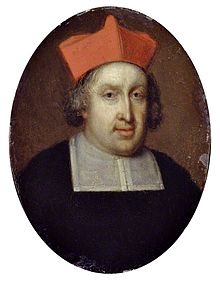Philip Thomas Howard
Philip Thomas Howard OP (born September 21, 1629 in Arundel House, London , † June 17, 1694 in Rome ) was an English nobleman , Dominican and cardinal .
Origin and family
He was born the third son of Henry Howard, 22nd Earl of Arundel and Lady Elizabeth Stewart (Stuart) , daughter of Esmé Stewart, 3rd Duke of Lennox . One of his brothers was Henry Howard, 6th Duke of Norfolk , both great-grandfather of Saint Philip Howard, 20th Earl of Arundel , who died in 1595 for his Catholic faith in the Tower of London . Another cardinal of the family was Edward Henry Howard (appointed in 1877)
Life
After a short teaching time at St John's College, Cambridge , Philip Howard went to Italy and entered the Dominican Order on June 28, 1645 , where he received the religious name Thomas. On October 19 In 1646 he finished the novitiate and laid in Rome his profession from 1652 he received in Rennes , the ordination .
Philip Thomas Howard returned briefly to England in 1655. He then founded a Dominican priory with an attached college for young Englishmen in the Flemish Bornem and became prior there . In Vilvoorde he founded a Dominican convent (Second Order).
After the death of the dictator Oliver Cromwell , Howard acted as secret ambassador for the English king in exile, Charles II ; after his accession to the throne in 1660, he played an active role in initiating the marriage with the Catholic Katharina von Braganza . Philip Thomas Howard was one of the very few Witnesses who attended the couple's Catholic wedding. He then became the Queen's court chaplain and, in 1665, Grand Almosier. He resided in the Palace of Whitehall . The duties of the office corresponded roughly to those of the Grand Almosenier of France . On 16 May 1672 Pope appointed him Clement X to the titular bishop of Helenopolis in Bithynia and awarded him the next day the right to the exercise of episcopal functions for the whole of England. There was no regular Catholic hierarchy there at the time.
Under political pressure from Anglican circles, Philip Thomas Howard had to leave England in 1674 and took his residence in exile in the Bornem monastery he had founded. Clemens X. appointed him cardinal priest in the consistory of May 27, 1675 , he received the cardinal's hat on March 23, 1676 together with the titular church of Santa Cecilia . On September 25, 1679 he moved to the titular church of Santa Maria sopra Minerva , on January 24, 1689 he was camerlengo of the College of Cardinals . He took part in the conclaves of 1676 (election of Innocent XI ), 1689 (election of Alexander VIII ) and 1691 (election of Innocent XII ). In the last two conclaves and Sedisvakanzen he was the Camerlengo state affairs of the Papal States and organized the papal election.
Howard died on June 17, 1694 in the Dominican monastery of Santa Sabina in Rome. He was buried in his titular church, the basilica of Santa Maria sopra Minerva , where his grave monument is also located.
literature
- Howard, Philip Thomas . In: Dictionary of National Biography. 1885–1900, Volume 28, (digital edition)
- Wilfrid Lescher: Philip Thomas Howard . In: Catholic Encyclopedia , Volume 7, Robert Appleton Company, New York 1910.
- Alessandro Cont: Corte britannica e Stati italiani. Rapporti politici, diplomatici e culturali (1685-1688) , prefazione di Christopher Storrs ("Biblioteca della Nuova Rivista Storica", 55), Roma, Società Editrice Dante Alighieri, 2019, ISSN 1124-2493 , ISSN 0469-2462 ( online ), Pp. 41-77.
Web links
- Howard of Norfolk, OP, Philip Thomas. In: Salvador Miranda : The Cardinals of the Holy Roman Church. ( Florida International University website), accessed July 25, 2016.
| personal data | |
|---|---|
| SURNAME | Howard, Philip Thomas |
| BRIEF DESCRIPTION | English nobleman, Dominican and cardinal |
| DATE OF BIRTH | September 21, 1629 |
| PLACE OF BIRTH | Arundel House, London |
| DATE OF DEATH | June 17, 1694 |
| Place of death | Rome |
